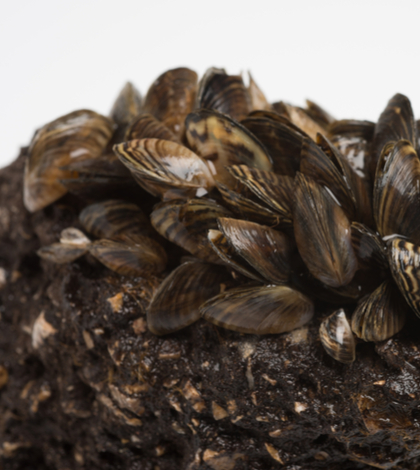The Bureau of Reclamation is looking for solutions to eradicate invasive quagga and zebra mussels in open waters especially large reservoirs, lakes and rivers. The prize competition is for 100-percent eradication of the invasive mussels in both a cost-effective and environmentally sound manner.
Although the challenge consists of three stages, the first stage is a theoretical competition. Reclamation has earmarked $100,000 for the first challenge to be divided among up to five winners. Those winners can then participate in stage two which is structured to provide proof-of-concept in a laboratory-scale demonstration. Stage 3 is planned as a field-scale demonstration where the selected treatment(s) will be deployed in a small-scale, closed-system open water environment to determine if the deployment and monitoring methodology is sufficient to produce and demonstrate large-scale dreissenid mussel mortality.
Zebra mussels (Dreissena polymorpha) and quagga mussels (Dreissena rostriformis “bugensis”) were first detected in the late 1980s and they have subsequently spread throughout much of the eastern United States. Quagga mussels have been found in various Reclamation (western United States) managed waters following their discovery in Lake Mead in 2007. However, zebra mussels remain largely confined to eastern states, though several populations have been documented in the West, including San Justo Reservoir about three miles southwest of Hollister, CA.
Invasion of open waters by these mussels have ecological, business, recreational and economic impacts. They are prolific breeders and frequently lodge on water facility infrastructure – boats, diversion screens, gates, hydropower equipment, pipelines, pumps, water intakes and the like. Invasive mussels can be a threat to native and endangered species leading to costly, increased intervention by local agencies.
Some of the worst scenarios of mussels’ infestations can be water and hydropower infrastructure that can fail or choke off water transmissions and complete restrictions of water recreation thereby significantly impacting a local economy.
The prize competition is looking for novel treatments or approaches that build upon existing treatments. They must be specific to invasive mussels without significant harm to non-target organisms such as native mussels or threatened and endangered species. They must already be in compliance with existing federal discharge permits and environmental protection regulations or must be implementable with reasonable modifications to existing regulations. Successful treatments must be cost-effective and scalable to large water bodies.
“Currently, no known broad scale application for open water exists to safely eradicate mussels in an environmentally sound manner,” said David Raff, Reclamation’s science advisor.
Reclamation has collaborating with the U.S. Geological Survey, the U.S. Army Corps of Engineers and Molloy & Associates for this innovative prize competition. Submissions for the challenge are due by February 28, 2018.
Please direct any requests for clarifications and additional information about this challenge to www.InnoCentive.com. To submit your questions to InnoCentive, you must first register for the competition at the InnoCentive website. Once you have registered, you will be able to see the full details of this challenge.
 California Water News Daily Your Source For Water News in California
California Water News Daily Your Source For Water News in California


